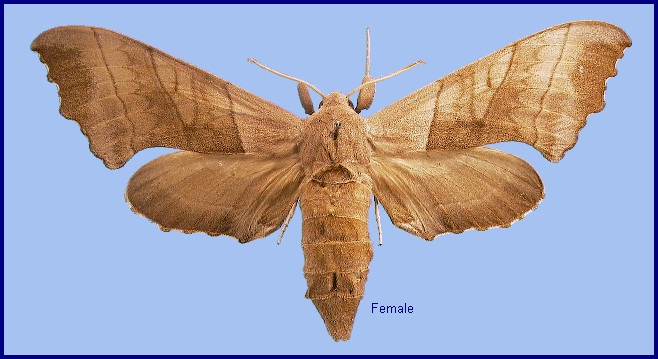
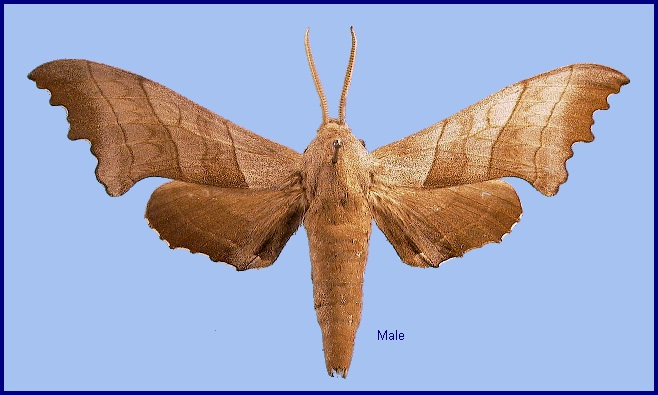
Sphinx dentatus Cramer, 1777, Uitlandsche Kapellen (Papillons exot.) 2: 42, pl. 125, fig. D. Type locality: [India,] "Coromandel" [Tamil Nadu/Andhra Pradesh].
Synonym. Sphinx dentatus Cramer, 1777.
Synonym. Sphinx timesius Stoll, 1790.
Synonym. Sphinx modesta Fabricius, 1793.
Wingspan: 92--120mm. Similar to Polyptychus trilineatus and Polyptychus chinensis but distinguishable by the straight submarginal line between forewing veins M2 and Cu2; outer margin strongly crenulated. Forewing upperside ground colour grey-brown with darker brown transverse lines; antemedian, postmedian and submarginal lines well-developed and almost straight; median line sinuous and inconspicuous; a strongly serrate line present between postmedian and submarginal lines.
In the male genitalia, uncus not strongly narrowing apically, apex emarginate with pointed angles. Gnathos median lobe large, deeply divided into two apically rounded lobes. Valve sole-shaped; stridulatory scales absent. Harpe with a short, spatulate submedial process and a long spine-like ventral process. Phallus with a very long and slender apical process that is recurved anteriorly and somewhat moveable basally somewhat. In the female genitalia, eighth tergite (A8) trilobate, median lobe very short. Sterigma markedly different from Polyptychus trilineatus; lamella antevaginalis convex, raised at ostium bursae into a thick, convex ridge and with a median lobe; lamella postvaginalis not strongly sclerotized, sunken, triangular.
The moths do not come to light or flowers, and bred females do not attract wild males readily (Bell & Scott, 1937). A species of drier areas.
The moth rests with the wings held horizontal and not touching the abdomen, which is held strongly up-curved in the male, straight in the female (Bell & Scott, 1937).
China: [Not present].
OVUM: Eggs laid singly on the underside of a leaf of the hostplant, which is usually Cordia dichotoma G. Forst., but the larva will also feed on Ehretia laevis Roxb., both of the family Boraginaceae (Bell & Scott, 1937).
LARVA: Full-fed 100mm, width 15mm. A species with six instars, the first of which does not eat any plant material.
According to Bell & Scott (1937), in the first instar head round, body cylindrical, long and thin horn short, straight, bifid. Head and body patio-green, horn darker green. In the second instar, head large, triangular, with a long pointed process rising from the vertex of each lobe, the two, processes closely oppressed to near the tips, which are shortly bifid. Body cylindrical, long and thin; horn long, straight, tapering to a simple point; surface smooth except for the head-processes and the horn, which are tuberculate. The colour of the head pale green, the processes from their tips to the nape of the neck brown with black tubercles; the body yellowish-green with quadrate black patch on the dorsum of segment 2 and V-shaped, pale brown markings on the dorsum of 4 to 12, the apex of the V pointing frontad; horn brown with black tubercles. In the third instar, shape as in the second instar. Head processes as long as the head itself, the surface with small tubercles. Body with a encircling row of small tubercles around each secondary ring. There is a subdorsal line of large pointed tubercles from the front margin of segment 2 to base of horn. Tubercles on head processes and horn as in second instar; colour as in the second instar, but the tubercles on head and body white. There is a broad yellow subdorsal stripe on which the subdorsal line of tubercles lies, as well as seven pale green oblique lateral stripes with V-shaped markings forming backward extensions to the oblique stripes. Horn as in the second instar; legs reddish. The fourth instar is similar to the third instar, except that the head and segment 2 are pale-green, the rest of the body apple-green. Head-processes darker green with reddish tubercles; the tubercles on body reddish above the spiracular line, white below it. There is sometimes a brown patch on each side of segment 12 between the base of the horn and the spiracular line, white below it. Horn green with reddish tubercles; legs red; spiracles reddish. The fifth instar is similar to the fourth instar. The body now increases in diameter from segment 2 to 7, then decreases slightly to 12. The horn is held nearly horizontal.
In the sixth and final instar, head rounded-triangular, the vertex rounded, without processes; clypeus small, triangular. Surface of head somewhat shiny, covered with small, rounded tubercles. Body stout for its length. Horn of medium length, stout at base and tapering evenly to a blunt point, strongly down curved. Segment 2 of the body as broad as the head, and the segments gradually increasing in diameter to about 7, then very gradually decreasing to 12. Surface of body dull, covered sparsely with small pointed tubercles, arranged somewhat irregularly on the dorsum and around the secondary rings in lateral area. There are a few tubercles on the bases of the prolegs, and a subdorsal line of larger tubercles from front margin of segment 2 to near base of horn; some of these tubercles with two or three points, forming a serrate ridge. Horn tuberculate (Bell & Scott, 1937).
In colour, head bluish-green, the tubercles white; labrum shiny, pale brown; basal segment of antenna whitish, the other segments blackish-brown with a white ring round each mandible brown with the tip darker. Body yellowish-green above the subdorsal line of tubercles, bluish-green below it; the smaller tubercles on the body violet with yellow tips; the subdorsal line of larger tubercles pink or purple. There are whitish or yellowish oblique lateral stripes clearly defined on 8 to 11, faint on the anterior segments, that on 11 extending backward to base of horn. In some larvae there are purple or brownish-purple triangular patches between the upper part of each oblique stripe and the subdorsal line of tubercles, and broader rounded patches above this line, the patches not reaching dorsum. Horn yellowish-green with the tubercles yellow or purplish; true legs pink with yellow tubercles; prolegs a claspers bluish-green, with yellow or purplish tubercles, the clasper with a violet-brown band at the distal edge. Spiracles oval, flush, pale violet or reddish, the central slit white edged with black (Bell & Scott, 1937).
Like in Marumba, the newly hatched larva eats the egg-shell and then rests without eating for about two days, whereupon it makes the first moult and only then commences feeding on leaves. This habit of eating nothing but the egg-shell also occurs in Polyptychus trilineatus. In later instars the larva eats the end-half of the leaves only, and its presence may be detected by looking out for leaves cut sharply across the middle. The larvae are very subject to attack by parasites, chiefly Tachinidae. The dorsal area turns brown before pupation, which takes place in a cell underground (Bell & Scott, 1937).
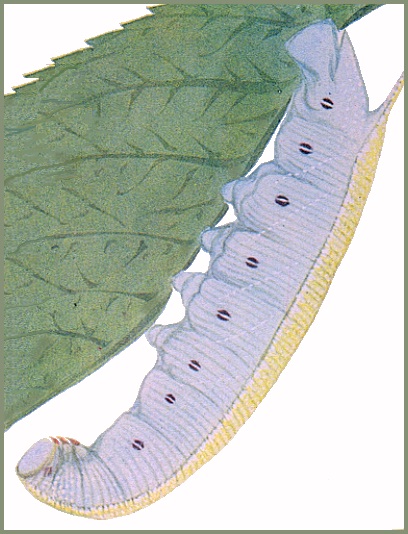
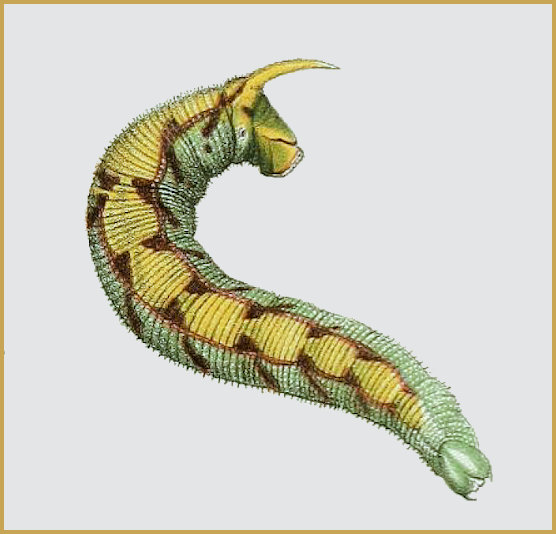
PUPA: 47mm. Very closely resembles that of Polyptychus trilineatus, the only notable differences being that in P. dentatus the dorsum of segment 2 is more rugose, and these rugosities are black, and the dorsal line of the same segment is generally raised into a ridge.
As in the case of some species of the genus Clanis the larva may lie quiescent underground for six months or more before pupating, the moth then emerging soon after pupation has taken place (Bell & Scott, 1937).
Larval hostplants. In India on Cordia dichotoma, Cordia sebestena and Ehretia laevis (Boraginaceae) (Bell & Scott, 1937).
China: Not present. So far, records from Yunnan, China, are misidentifications of Polyptychus chinensis.
Sri Lanka, tropical India, tropical Pakistan (Rafi et al., 2014) and Bhutan (Irungbam & Irungbam, 2019).
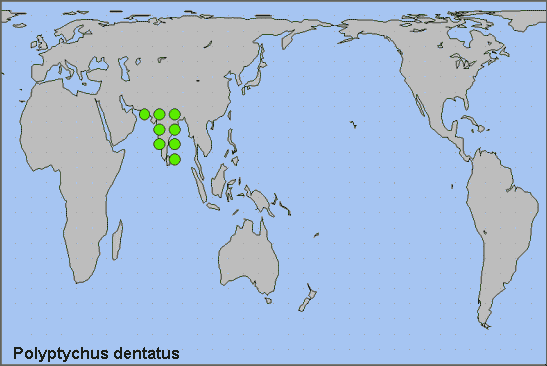
 Return to Sphingidae of the Eastern Palaearctic species list
Return to Sphingidae of the Eastern Palaearctic species list